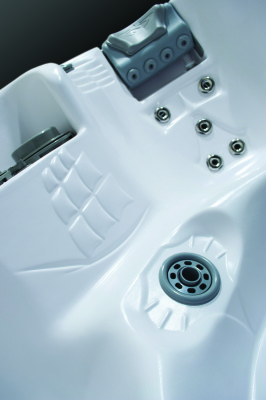Improved therapeutic capabilities

Thanks to better plumbing efficiency and pump schematics, massage and therapeutic capabilities has been heightened in modern hot tub designs. For example, new specialized jet designs can target certain muscle conditions and provide a large variety of massage techniques, including deep tissue and acupressure.
A hot tub can have as many as three hydrotherapy pumps to facilitate targeted therapy designs. These special, high-volume pumps are designed to accommodate higher jet counts, while still maintaining high system pressures. These plumbing systems also feature spa-side diverter controls, which give the end user complete control over water flow, volume and direction.
Jet nozzles have also evolved in recent years to promote adjustability, while a large variety of speciality jets are also now available to further enhance hydrotherapy options. These include high-flow whirlpool, rotating, dual-rotating, directional, pulsating and rifling configurations, all of which allow designers and end users to customize hot tub seats to solve specific medical or massage needs.
Improved functionality
Improvements in controls and electronics have greatly impacted today’s hot tub designs, as well. In early hot tubs, air switches were used to turn pumps on/off and temperature controls were often hard to locate (e.g. behind a cabinet panel) and use. As solid-state electronics improved, an all-in-one component system, called the spa pack (circa 1977), united the pump, heater, control, blower and plumbing systems. This was the beginning of the never-ending march towards sophistication in the hot tub industry.
Today, these controllers feature colour screens with menus similar to what can be found on a cellphone. They allow consumers to easily set maintenance cycles and even save settings in a power outage. Most hot tubs can even be operated via remote control, which can operate the lights, pumps and even audio and video features. The trend is continuing to allow for integration into other modern electronics like smartphones.
Easier care and maintenance
As self-contained hot tubs became more sophisticated, water management systems also improved. In addition to the hot tub’s pump and filter, bromine, chlorine and/or heavy minerals (the same materials mariners used to keep water clean on long voyages) are used as the primary sanitizer. Often these are supplemented with an ozone generator, ultraviolet light (UV) sterilization and/or ionizers as a popular way to decrease the use of common hot tub chemicals.
New technologies have positively impacted the evolution of modern water management options, with ozone being the most common. These systems are not chemical-free, but are easier to maintain and use fewer chemicals.
Other sophisticated water management systems combine ozone with UV light to improve water quality and create a clean, healthy bathing environment without sacrificing efficiency. These dynamic systems use less power than a standard light bulb and result in average monthly heating costs ranging from $15 to $25.
Monthly ownership costs can be higher with hot tubs that are not equipped with circulation pumps, as the water management system is using less-efficient jet pumps to keep the water clean. Modern circulation pumps are magnetic-driven and the heat they generate is returned to the water to reduce the need for additional heating.
Conclusion
Water therapy has been utilized in several different forms throughout history. Ever since the early use of hot baths and mineral waters for healing purposes, people have been improving and advancing both the hot tub concept and the breakthrough technology behind them. As the industry continues to combine the knowledge of yesteryear with 21st century methodology, the future of the hot tub industry continues to look bright.
 Vic Walker is the product design manager at Dimension One Spas, a hot tub manufacturer in Vista, Calif. He has almost 20 years experience as an industrial designer and more than 12 years experience in the pool and hot tub industry where he has been awarded more than 15 patents for his contributions. He can be reached at vwalker@d1spas.com.
Vic Walker is the product design manager at Dimension One Spas, a hot tub manufacturer in Vista, Calif. He has almost 20 years experience as an industrial designer and more than 12 years experience in the pool and hot tub industry where he has been awarded more than 15 patents for his contributions. He can be reached at vwalker@d1spas.com.






